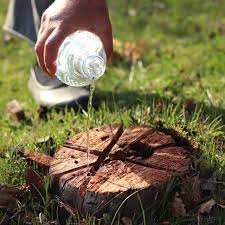The least labor-intensive technique to get rid of a tree stump is to use chemicals. However, this procedure does require some time, particularly if the stump is large.
Because you are essentially decaying the troublesome stump, in some circumstances the stump removal procedure could take up to a year to complete. The good thing is that if you already own a chainsaw and drill, this method is reasonably priced.
You can start once you have your supplies. But keep in mind that it usually takes at least four weeks to notice results when using a chemical stump remover. This is the fastest approach to quickly rot a tree stump that I am aware of. A stump typically takes three to seven years to decay.
An efficient chemical for eliminating a tree stump close to your home is potassium nitrate. It is frequently marketed specifically as a wood stripper. Potassium nitrate fully destroys wood by stimulating its breakdown. Its use will cause the stump to deteriorate more quickly than other methods.
Round-Up is a popular herbicide that kills trees (glyphosate). Drill several 6-inch-deep holes around the stump’s edge with a 1-inch spade bit extension before applying herbicide. Use a little paintbrush to apply. The stump will become dead as a result of the roots dying out.
Step 1: With your chainsaw, cut away as much of the stump as you can from the ground up. Make sure you are wearing protective safety gear, such as steel toe boots and safety eyewear.
Step 2: Now that the tree stump has been partially removed, it’s time to drill holes through it. Use the largest drill bit you can while precisely spacing the holes. With these holes, drill them as far and broad as you can.
Step 3: After adding the potassium nitrate, fill the holes with water. Another high-nitrogen fertilizer or even specially formulated stump-removal granules could be used.
Step 4: After thoroughly soaking the ground around the tree stump with water, cover the area with a plastic tarp. The tarp will aid in retaining moisture and hasten the rotting process.
Step 5: Spread mulch over the tarp, preferably one that is organic, and water the area once more to assist the mulch retain moisture.
Step 6: Check on the progress on a regular basis, replenish your tree stump with water and nitrogen, and then restore it with mulch and more water.
Step 7: Your tree stump should turn spongy after four to six weeks have elapsed. If so, you can hasten the procedure and partially remove the tree stump by using an axe. You can cover what’s left with dirt, make a flower bed, or even plant grass seed if enough of it comes away. Repeat the operation if the stump remains solid.
Conclusion
So, chemical stump removers perform a good job of accelerating a stump’s decomposition process, but they are not a quick fix. The decaying process might frequently take years. The size and condition of the stump typically determine how long it takes for the stump to entirely deteriorate.

